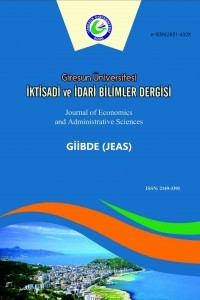COVID-19 VE DERİNLEŞEN YOKSULLUK
Covid-19, Pandemi, Salgın, Yoksulluk, Alkire-Foster
COVID-19 AND DEEPENING POVERTY
Covid-19, Alkire-Foster, Pandemic, Outbreak, Poverty,
___
- Alkire, S., Roche, J.M., (2012), “Beyond Headcount: The Alkire-Foster Approach to Multidimensional Child Poverty Measurement”, Editör: Isabel Ortiz, Louise Moreira Daniels, Solrun Engilbertsdottir, UNICEF, NewYork, 18-21.
- Bradshaw, J. (2001), “Child Poverty and Child Outcomes “, Chıldren & Socıety Vol: 16 (2002) pp. 131–140 Published online in Wiley InterScience (www.interscience.wiley.com). DOI: 10.1002/CHI.707
- Buheji, M., Katiane da Costa, C., Godfred, B., Bartola, M., Yuri, L., Simone, S,, Mohammed H. & Tulika, C. (2020), “The Extent Of Covıd-19 Pandemic Socio-Economic Impact on Global Poverty, A Global Integrative Multidisciplinary Review, American Journal of Economics, 10(4): 213-224.
- Decerf, B., Francisco H. G. F., Daniel G. M. & Olivier S. (2020), “ Lives and Livelihoods: Estimates of the Global Mortality and Poverty Effects of the Covıd 19 Pandemic”, IZA – Institute of Labor Economics, 1-37.
- Dünya Bankası, Poverty, https://data.worldbank.org/topic/poverty.
- Han, J., Bruce D. M. & James X. S. (2020), “Income and Poverty in the Covıd-19 Pandemic”, NBER Working Paper, No. 27729, 1-33.
- IMF (2020a), Gabriela, C. & Futoshi, N. “How COVID-19 Will Increase Inequality in Emerging Markets and Developing Economies”, October 29 2020, /https://blogs.imf.org/2020/10/29/how-covid-19-will-increase-inequality-in-emerging-markets-and-developing-economies/
- IMF (2020b), Daniel, G., Stefania, F. & Johannes, W. “COVID-19: Without Help, Low-Income Developing Countries Risk a Lost Decade”, August 27 2020, https://blogs.imf.org/2020/08/27/covid-19-without-help-low-income-developing-countries-risk-a-lost-decade/
- ILO (2020), “COVID-19 and the World of Work: Impact and Policy Responses”, Downloaded at https://www.ilo.org/wcmsp5/groups/public/---dgreports/--- dcomm/documents/briefingnote/wcms_738753.pdf
- Mukherjee, Joia S. (2007), “Structural Violence, Poverty and the Aıds Pandemic”, Development, 50(2), 115-121.
- Ningrum, P. A., Alexandra, H. & Saputra, A. (2020), “The Potential of Poverty in the City of Palangka Raya: Study Smıs Affected Pandemic COVID-19”, Budapest International Research and Critics Institute-Journal, (BIRCI-Journal), Volume 3, No 3, August, 1626-1634.
- OPHI, (2021), “Alkire-Foster Method”, https://ophi.org.uk/policy/alkire-foster-methodology/ Parolin, Z., Megan, C., Jordan, M., Jane, W. & Christopher, W. (2020), “Monthly Poverty Rates in the United States During the COVID-19 Pandemic, Poverty and Socıal Polıcy Workıng Paper, October 15, 1-24.
- Ratcliffe, C.&Mc Kernan, S-M. (2010), “Childhood Poverty Persistence: Facts and Consequences”, The Urban Institute, Brief 14 June, 1-10.
- Rowntree, B. S. (1901), Poverty, a Study of Town Life, Macmillan and Co. Limited, New York, 1-437.
- Suryahadi, A., Al Izzati, R., & Suryadarma, D. (n.d.). (2020), “Estimating the Impact of Covid-19 on Poverty in Indonesia, Bulletin of Indonesian Economic Studies, 1–34. https://doi.org/10.1080/00074918.2020.1779390
- Sumner, A., Hoy, C. & Ortiz-Juarez, E. (2020a), “Estimates of the Impact Of COVID-19 on Global Poverty”, Working Paper 2020/43, World Institute for Development Economics Research (WIDER), United Nations University, Helsinki.
- Sumner, A., Ortiz-Juarez, E. & Hoy, Chris. (2020b), “Precarity and the Pandemic: COVID-19 and Poverty Incidence, Intensity, and Severity in Developing Countries”, WIDER Working Paper, 2020/77, 1-24.
- Social Watch. (2019), “ILO: Poor Quality Employment a Major Challenge”, | Social Watch. Retrieved 12 May 2020, from http://www.socialwatch.org/node/18215
- Tavares, Fernando Flores & Betti Gianni (2021). “The Pandemic of Poverty, Vulnerability, and COVID-19: Evidence from a Fuzzy Multidimensional Analysis of Deprivations in Brazil”, World Development, Volume 139.
- TÜİK (2020). Gelir ve Yaşam Koşulları Araştırması, https://data.tuik.gov.tr/Bulten/Index?p=Gelir-ve-Yasam-Kosullari-Arastirmasi-2020-37404#:~:text=E%C5%9Fde%C4%9Fer%20hanehalk%C4%B1%20kullan%C4%B1labilir%20fert%20medyan,%21%2C9%20olarak%20ger%C3%A7ekle%C5%9Fti.
- University of Minnesota Libraries Publishing (2010), Social Problems: Continuity and Change, https://open.lib.umn.edu/socialproblems/chapter/2-4-the-consequences-of-poverty/#:~:text=Poor%20people%20are%20more%20likely%20to%20have%20several%20kinds%20of,likely%20to%20commit%20street%20crime
- UN (2020a), Everyone Included: Social Impact of COVID-19. https://www.un.org/development/desa/dspd/everyoneincluded-covid-19.html), Everyone Included: Social Impact of COVID-19 | DISD (un.org)
- UN (2020b), UN/DESA Policy Brief #86: The Long-term Impact of COVID-19 on Poverty, 15 October 2020.
- UNU (2020), UNU.edu (https://unu.edu/news/news/covid-19-could-drive-global-poverty-back-over-one-billion-people.html)
- UNDP (2019), “Global Multidimensional Poverty Index 2019”, United Nations Development Programme and Oxford Poverty and Human Development Initiative, 1-21.
- World Vision (2021), “What is Poverty? It’s not as Simple as you Think”, https://www.worldvision.ca/stories/child-sponsorship/what-is-poverty
- Yasmin S., Alam M.A., Bin Ali F., Banik Rr.& Salma N. (2021 ), “ Psychological Impact of Covıd-19 among People from the Banking Sector in Bangladesh: A Cross-Sectional Study, International Journal of Mental Health and Addiction, https://doi.org/10.1007/s11469-020-00456-0
- ISSN: 2149-3391
- Yayın Aralığı: Yılda 2 Sayı
- Başlangıç: 2015
- Yayıncı: Giresun Üniversitesi
TÜRKİYE’DE BÜYÜKŞEHİR STATÜSÜNE SAHİP İLLERİN SAĞLIK HİZMETLERİ PERFORMANSININ DEĞERLENDİRİLMESİ
Mustafa ÖZDEMİR, Onur ÇATALTEPE
İDT VE KİK STATÜ FARKLILIKLARI VE STATÜ BELİRLEMEYE YARDIMCI BİR ANALİZ: TMO ÖRNEĞİ
Trake, Bronş Ve Akciğer Kanserinin Küresel Yükünün Zamansal Trendlerinin Karşılaştırılması
İskender ÇETİNTÜRK, Vahit YİĞİT
EĞİTİM SİSTEMİNİN GİRİŞİMCİLİK DAVRANIŞI ÜZERİNDEKİ ETKİSİ: FİNLANDİYA ÖRNEĞİ
KRiPTO PARA VE PARANIN FONKSİYONLARI
